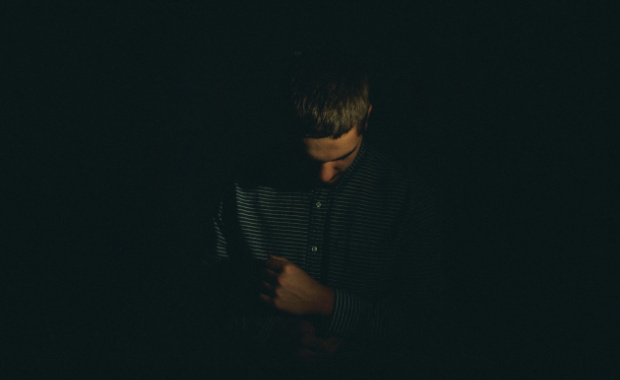Life
How Your Psychological Blind Spots Keep You Stuck in Life

Sometimes, life doesn’t seem to make any sense. Albert Einstein once said “insanity is doing the same thing over and over and expecting different results.” Here’s the funny thing. We will say that line about someone else, have a good chuckle, and then DO THE SAME THING OURSELVES! This time, it’s not that funny, is it? I know. I’ve done it myself.
I will be sharing 3 examples of seemingly paradoxical behaviour from people who have been in my private practice. (Of course, I have changed the names and some of the demographics to respect their confidentiality).
- Tom complains about how he has never had any money and then proceeds to order in for the 4th time that week.
- Bev tells me how there are no more good men out there in the world. However, weeks later, she tells me about laughing flirtatiously when a guy was mocking other people at the party, and who is now mocking her laugh and some of her physical features.
- Alexa, a business owner, spends $3000 on a marketing course but then continues to spend too much time and charge too little for her services and never gets to the new clients she attracted with the marketing methods she learned with the course.
On the surface it would seem like these people are “insane” according to Einstein’s definition. But as I have seen in my psychotherapy practice for the last 12 years, these are not atypical stories. In fact, I have seen this seemingly contradictory behaviour in friends, family, colleagues and so many others that it cannot be insanity. It is indeed a human condition.
So, what the heck is going on here?
Well, things become a little clearer when you look below the surface. There are actually two different behaviours at work here. One, the subconscious, is acting on fears experienced years before, often in childhood. These subconscious behaviours and underlying fears are often maintained through life unless they are dealt with in adulthood. I call these patterns people’s psychological blind spots.
The other behaviour is based on what our rational conscious brain sees. It interprets what it sees or doesn’t see in the present moment and comes to a conclusion based on reason.
Now, let’s go back and review the 3 cases with these two different perspectives:
- Tom grew up seeing his parents constantly living on credit card debt for years and just complaining about it daily. He told me he was seriously afraid of ending up on the streets. As a child, buying something would temporarily distract him from his biggest fear. Tom’s conscious brain doesn’t see what the subconscious brain sees and rationalizes his overspending by saying, “Why shouldn’t I enjoy my life too?”
- Bev was often not even “seen” in her family of six siblings and she grew up believing that she was unlovable. She noticed that when she was dating someone, that fear was briefly abated. So, she subconsciously lowered her standards for the men she sought because any relationship was better than being alone, or so she thought. Bev’s conscious logical brain continues to rationalize or explain away “bad behaviour” early in her relationships. It says things like, he was short with me because he is under a lot of pressure at work.
- Alexa was deeply affected by her parents’ constant arguments and eventual divorce when she was seven years old. She felt responsible for their divorce and believed she just wasn’t good enough as she was. She noticed that when she did things for her father, he would briefly pay attention to her. So, she became the ‘Pleaser’ in the family. She grew up subconsciously feeling that she was unworthy when she wasn’t making someone else happy. This has carried over into her business relationships as she overextends herself and thereby, devalues herself with clients. On the other hand, her conscious brain tells her that she has to treat her clients well or they will tell others about her poor service.
So, now that you understand how to explain the seemingly contradictory behaviour, how do you reconcile these two radically different perspectives? What can you do about it when you get stuck and come up against a pattern you can’t seem to shake?
There is a new way to approach these challenges in life. I call it your True Self way. I define your True Self as the one you are in when you feel inner peace or fully engaged or in the flow. Your True Self sees its own strengths and weaknesses and accepts and loves all of itself. And it is able to be open and vulnerable enough to admit them. It is curious and connects well with others. It is your most balanced self. Everyone has moments when they are in their True Self. It does take practice to learn how to get into this state at will.
Let’s look at how your True Self would approach each of the situations above:
- Tom’s True Self understands his subconscious fears and takes responsible action. For enjoyment, he goes bike riding but also gets on a schedule to start paying down his debt.
- Bev’s True Self appreciates her subconscious fears and begins to love her inner wounded child who feels unlovable. In addition, she starts to watch the actions men take early on in the relationship and assume those actions represent who he really is.
- Alexa’s True Self understands the Pleaser part and aligns with it by beginning to please herself first, and others second. Now, she is not only satisfying her clients in a fair way, she is also satisfying herself and growing her company.
For many people, it can come as a revelation to finally understand why you keep making the same mistake over and over again or keep coming up against a brick wall and can’t seem to take your business to the next level. No, you are not insane. And no, you are not alone. Most people run some sort of “self-sabotaging’ pattern in their life and most of those people can’t see it. It’s often difficult to see your own subconscious patterns. It’s like trying to see your own back.
When you begin to align your conscious and subconscious beliefs and behaviours, your life and business begin to make sense. You will feel like you are waking up from a semi-comatose state. You will feel more energized and connected to others. You will also make decisions quicker because you are more focused and clearer about what you really want. You will get unstuck and begin making real progress, maybe for the first time in your life. And that will probably be the sanest thing you can do.
Did You Know
How Skilled Migrants Are Building Successful Careers After Moving Countries
Behind every successful skilled migrant career is a mix of resilience, strategy, and navigating systems built for locals.

Moving to a new country for work is exciting, but it can also be unnerving. Skilled migrants leave behind familiar systems, networks, and support to pursue better job opportunities and a better future for their families. (more…)
Life
10 Research-Backed Steps to Create Real Change This New Year
This New Year could finally be the one where you break old patterns and create real, lasting change.

Every New Year, we make plans and set goals, but often repeat old patterns. (more…)
Life
9 Harsh Truths Every Young Man Must Face to Succeed in the Modern World
Before chasing success, every young man needs to face these 9 brutal realities shaping masculinity in the modern world.

Many young men today quietly battle depression, loneliness, and a sense of confusion about who they’re meant to be.
Some blame the lack of deep friendships or romantic relationships. Others feel lost in a digital world that often labels traditional masculinity as “toxic.”
But the truth is this: becoming a man in the modern age takes more than just surviving. It takes resilience, direction, and a willingness to grow even when no one’s watching.
Success doesn’t arrive by accident or luck. It’s built on discipline, sacrifice, and consistency.
Here are 9 harsh truths every young man should know if he wants to thrive, not just survive, in the digital age.
1. Never Use Your Illness as an Excuse
As Dr. Jordan B. Peterson often says, successful people don’t complain; they act.
Your illness, hardship, or struggle shouldn’t define your limits; it should define your motivation. Rest when you must, but always get back up and keep building your dreams. Motivation doesn’t appear magically. It comes after you take action.
Here are five key lessons I’ve learned from Dr. Peterson:
-
Learn to write clearly; clarity of thought makes you dangerous.
-
Read quality literature in your free time.
-
Nurture a strong relationship with your family.
-
Share your ideas publicly; your voice matters.
-
Become a “monster”, powerful, but disciplined enough to control it.
The best leaders and thinkers are grounded. They welcome criticism, adapt quickly, and keep moving forward no matter what.
2. You Can’t Please Everyone And That’s Okay
You don’t need a crowd of people to feel fulfilled. You need a few friends who genuinely accept you for who you are.
If your circle doesn’t bring out your best, it’s okay to walk away. Solitude can be a powerful teacher. It gives you space to understand what you truly want from life. Remember, successful men aren’t people-pleasers; they’re purpose-driven.
3. You Can Control the Process, Not the Outcome
Especially in creative work, writing, business, or content creation, you control effort, not results.
You might publish two articles a day, but you can’t dictate which one will go viral. Focus on mastery, not metrics. Many great writers toiled for years in obscurity before anyone noticed them. Rejection, criticism, and indifference are all part of the path.
The best creators focus on storytelling, not applause.
4. Rejection Is Never Personal
Rejection doesn’t mean you’re unworthy. It simply means your offer, idea, or timing didn’t align.
Every successful person has faced rejection repeatedly. What separates them is persistence and perspective. They see rejection as feedback, not failure. The faster you learn that truth, the faster you’ll grow.
5. Women Value Comfort and Security
Understanding women requires maturity and empathy.
Through books, lectures, and personal growth, I’ve learned that most women desire a man who is grounded, intelligent, confident, emotionally stable, and consistent. Some want humor, others intellect, but nearly all want to feel safe and supported.
Instead of chasing attention, work on self-improvement. Build competence and confidence, and the rest will follow naturally.
6. There’s No Such Thing as Failure, Only Lessons
A powerful lesson from Neuro-Linguistic Programming: failure only exists when you stop trying.
Every mistake brings data. Every setback builds wisdom. The most successful men aren’t fearless. They’ve simply learned to act despite fear.
Be proud of your scars. They’re proof you were brave enough to try.
7. Public Speaking Is an Art Form
Public speaking is one of the most valuable and underrated skills a man can master.
It’s not about perfection; it’s about connection. The best speakers tell stories, inspire confidence, and make people feel seen. They research deeply, speak honestly, and practice relentlessly.
If you can speak well, you can lead, sell, teach, and inspire. Start small, practice at work, in class, or even in front of a mirror, and watch your confidence skyrocket.
8. Teaching Is Leadership in Disguise
Great teachers are not just knowledgeable. They’re brave, compassionate, and disciplined.
Teaching forces you to articulate what you know, and in doing so, you master it at a deeper level. Whether you’re mentoring a peer, leading a team, or sharing insights online, teaching refines your purpose.
Lifelong learners become lifelong leaders.
9. Study Human Nature to Achieve Your Dreams
One of the toughest lessons to accept: most people are self-interested.
That’s not cynicism, it’s human nature. Understanding this helps you navigate relationships, business, and communication more effectively.
Everyone has a darker side, but successful people learn to channel theirs productively into discipline, creativity, and drive.
Psychology isn’t just theory; it’s a toolkit. Learn how people think, act, and decide, and you’ll know how to lead them, influence them, and even understand yourself better.
Final Thoughts
The digital age offers endless opportunities, but only to those who are willing to take responsibility, confront discomfort, and keep improving.
Becoming a man today means embracing the hard truths most avoid.
Because at the end of the day, success isn’t about luck. It’s about who you become when life tests you the most.
Change Your Mindset
The Four Types of Happiness: Which One Are You Living In?
Most people chase success only to find emptiness, this model reveals why true happiness lies somewhere else.

In a world driven by rapid technological growth and constant competition, many people unknowingly trade joy for achievement. (more…)
-

 Did You Know4 weeks ago
Did You Know4 weeks agoThe Success Patterns You Inherited (And Didn’t Notice)
-

 Entrepreneurs3 weeks ago
Entrepreneurs3 weeks agoThe Essential Skills Every Entrepreneur Needs In 2026
-

 Business4 weeks ago
Business4 weeks agoThe Hidden Money Pit in Your Operations (and How to Use It)
-

 Change Your Mindset3 weeks ago
Change Your Mindset3 weeks agoHow to Turn Your Mind Into Your Greatest Asset (Instead of Your Enemy)
-

 Change Your Mindset2 weeks ago
Change Your Mindset2 weeks agoThe Silent Skill That Makes People Respect You Instantly
-

 Life2 weeks ago
Life2 weeks ago10 Research-Backed Steps to Create Real Change This New Year
-

 Tech2 weeks ago
Tech2 weeks agoWhat’s in a Name? How to Get Your Domain Right
-

 Did You Know1 week ago
Did You Know1 week agoHow Skilled Migrants Are Building Successful Careers After Moving Countries
























